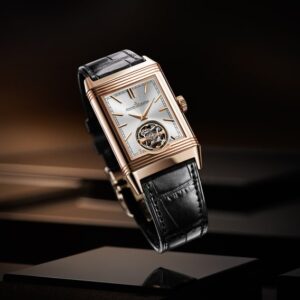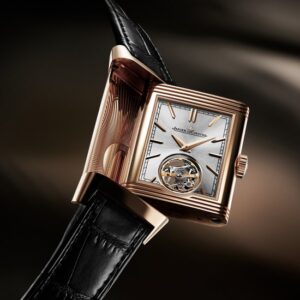JAEGER-LECOULTRE CELEBRATES THE UNIQUE FORMULA THAT GOVERNS THE TIMELESS DESIGN OF THE REVERSO

In 2023, Jaeger-LeCoultre celebrates a mystical number represented by the letter φ (Phi) and recognised as a universal signifier of beauty. Known today as the Golden Ratio, it is a common denominator for beauty and harmony shared by the natural world and man-made masterpieces – a proportion that humans instinctively find to be the most aesthetically pleasing.
Simplified as 1.618, the Golden Ratio (also called the Golden Mean, Golden Section, Golden Number or Divine Proportion) represents the unique relationship within an object, where the ratio of a larger part to a smaller part is the same as the ratio of the larger part to the whole. This intriguing mathematical relationship also translates into so-called golden spirals and rectangles. A golden rectangle is one in which, if a square is cut from it, with sides the same length as the rectangle’s shorter side, the remaining rectangle has the same proportion as the original rectangle.
In watchmaking, Jaeger-LeCoultre’s Reverso expresses this principle with utmost eloquence. Created in 1931 at the height of the Art Deco artistic movement, which emphasised geometric patterns, rectilinear shapes and clean lines, the original design of Reverso was governed by the Golden Ratio. While many variations of the Reverso case have been presented over the nine decades since then, the original proportions have remained as an anchor for the collection and the Golden Ratio continues to define the Reverso’s design today.
The Fascinating Relationship Between Geometry and Aesthetics
As humans we are innately attracted to beauty and, for thousands of years, civilisations have tried to unlock its secrets – to understand why we seek it, how to define it, and how to measure the basis of its appeal.
In 1931, the same year that the Reverso was designed, Matila Ghyka, a Romanian prince, philosopher and mathematician, published The Golden Number – a sequel to his Aesthetics of Proportions in Nature and in the Arts of 1927. These works summed up the many ways that Phi can be found not only in familiar organic forms, such as the spirals of shells, the arrangement of flower petals and the structure of pine cones, but also on the infinitely greater scale of the shape of galaxies and the whirling eye of hurricanes. The Golden Number also identified the presence of Phi in the most beautiful creations of humanity, explaining how its secrets were sought for their value in architecture, art and music, and tracing how its mysteries have been transmitted in an unbroken line from the Pythagorean mathematics of Ancient Greece to the present day. In this way, Ghyka provided a portal to a deeper understanding of the spiritual nature of beauty and the hidden harmonies that connect the whole of creation.
For the watchmakers of Jaeger-LeCoultre, surrounded by the fields, mountains and ancient forests of the Vallée de Joux, this unassailable connection between the aesthetic language of nature and man’s capacity to create beautiful objects is particularly meaningful.
A Long History
The inquiry into these mysteries began more than two millennia before Matila Ghyka’s writing: in 300 BC Euclid, in his Elements of Geometry, described what he termed “the extreme and mean ratio” – the first written definition of Phi. Even earlier, in the 6th century BC, the philosopher and mathematician Pythagoras examined the mystical properties of geometry, and the sculptor Phidias is said to have applied the Golden Ratio to the ornaments he made for the Parthenon, around 430 BC.
During the 12th century, Leonardo Pisano, better known as Fibonacci, set out the recurrence algorithm or number sequence that bears his name (0, 1, 1, 2, 3, 5, 8, 13, 21, 34, 55, 89…). Each number is obtained by the sum of the two previous ones and thus, when we divide each number by the previous number, we obtain a value close to Phi. Remarkably, it is this sequence that defines the golden spirals found in nature. Three centuries later, the astronomer Johannes Kepler revealed the indisputable correspondence between the divine proportion and the Fibonacci sequence.
In 1498, the treatise La Divina Proportione, by Luca Pacioli, with illustrations by Leonardo da Vinci, laid down the proportions to be respected in order to achieve supreme beauty, thus establishing the essential elements that have marked European history and art ever since.
Whether intentionally or through a natural instinct for beauty, great architects and artists have employed these proportions in their work since time immemorial – from the pyramids of Giza and the Babylonian Tablet of Shamash (888–885 BC) to the Gothic cathedral of Chartres and the 20th-century master Le Corbusier; from the great Renaissance artists, including Raphael, Botticelli and Michelangelo, to the Post-Impressionist Seurat and, later, Salvador Dalí, Piet Mondrian and the Section d’Or group of Cubist painters. Today, we see the proportion employed in many everyday objects, from the standard credit card to automotive designs and many brand logos.
The term golden section (goldener Schnitt) was first used in 1835 by the German mathematician Martin Ohm and popularised by the psychologist Adolf Zeising, who defined it as “the universal law in which is contained the ground-principle of all formative striving for beauty and completeness”.
Introducing New Reverso Models for 2023
At Watches and Wonders, Jaeger-LeCoultre introduces three new models to the Reverso Tribute collection – the standard-bearer for the Golden Ratio that governed the proportions of the Reverso designs of the early 1930s.
The Reverso Tribute Chronograph honours the ground-breaking Reverso Chronograph of 1996, reinventing it with the new Calibre 860 which, in addition to revealing the beautifully crafted chronograph mechanism on the reverse side, displays the time indication on both the front and reverse.
The Reverso Tribute Duoface Tourbillon presents the complication in an entirely new guise – as a flying tourbillon set within an ultra-thin Duoface movement, displaying a second time zone on the reverse dial.
Four new Reverso Tribute Small Seconds models introduce new dials to the collection, in colour variations from classical silver to rich burgundy and black. Being a Monoface Reverso, the case flips over to reveal the classical closed case-back, which offers an ideal canvas for personalised engravings and other decoration.
In addition, Jaeger-LeCoultre presents an artistic expression of the Reverso Calibre 179 in a redesigned case. With an array of finely crafted decorative details, including skeletonisation and lacquer work, amplifying the technical tour-de-force and impressive visual effect of the Gyrotourbillon, the Reverso Hybris Artistica Calibre 179 is a noble expression of the 180 watchmaking skills housed under one roof within the Manufacture Jaeger-LeCoultre.
For women, Jaeger-LeCoultre further highlights the artistic crafts housed within its Métiers Rares® atelier, as two new interpretations of the Reverso demonstrate the Maison’s boundless inventiveness and creativity.
The Reverso One Precious Colours is offered in two eye-catching colour variations: its entire case is adorned with a geometric Art Deco pattern of enamel and diamonds, in a visually arresting and boldly original execution of the art of grand feu enamel.
Presenting a fresh and elegant way for the 21st-century woman to wear the Reverso, the Reverso Secret Necklace is a magnificent jewel that demonstrates, once again, the Reverso’s ability to constantly reinvent itself while faithfully respecting the original design codes. In a case entirely set with diamonds and onyx in an Art Deco pattern, the watch is suspended from a sinuous supple chain necklace of pink gold links and onyx beads.
Watches and Wonders: a Spectacular New Booth and a Deeper, Multi-Sensory Experience
For Watches and Wonders 2023, Jaeger-LeCoultre takes inspiration from the agora of Ancient Greece – the period when Euclid recorded the earliest written reference to the Golden Ratio. Like the original agora, where people would gather to discuss everything from politics and judicial issues to business and philosophy, the booth represents the transmission of knowledge and is designed to encourage relaxed conversation as visitors discover the timepieces and the 2023 theme.
Viewed from above, elements of the floor plan conform to the proportions of golden rectangles and golden spirals, while at the heart of the space, a spectacular full-height water feature represents the monument that stood at the centre of each ancient agora.
Symbolising the source of creativity, the water acts as a ‘screen’ on which an enthralling digital show is projected, intensifying the sense of movement with light, images and sound, to tell the story of man’s quest to define the universal laws of beauty. In four chapters, the show traces the path from mankind’s observation of nature to our wonder at the essence of beauty and the first sparks of creative inspiration. It moves on to research and learning – the mathematics and philosophy that began to identify the ubiquity of certain proportions and, eventually, to the definition of these harmonies, which became the foundation for man-made beauty. The story concludes with the Reverso, which distils this quest into an object of beauty and a cultural symbol that has become a timeless icon.
Visitors to the salon can more deeply experience the 2023 theme through the Atelier d’Antoine, which will offer the opportunity to explore the theme through hands-on Discovery Workshops focusing on the Reverso, evoking the Golden Ratio as a key design element. The cultural universe of the Reverso will be further expanded by the presence of craftsmen from Casa Fagliano, the celebrated Argentinian bootmaker, who will demonstrate their exceptional artistry with leather. Since 2011, Casa Fagliano has collaborated with Jaeger-LeCoultre to make straps for the Reverso Tribute line. In addition, the 1931 Café makes its Watches and Wonders debut with a new selection of pastries composed by artist-pâtissier Nina Métayer that capture the essence of the Golden Ratio and the Vallée de Joux through flavour, texture and form.
Following Watches and Wonders, 2023, Jaeger-LeCoultre will continue the world tour of Reverso Stories, taking this fascinating and unforgettable exhibition to new cities, in an expanded form that presents the history of this great timepiece through the theme of the Golden Ratio.








